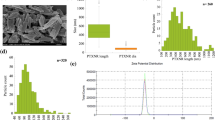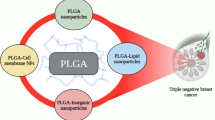Abstract
Purpose
The intratumoral heterogeneity observed in breast cancer (BC), in particular with regard to cell surface receptor expression, can hinder the success of many targeted cancer therapies. The development of novel therapeutic agents that target more than one receptor can overcome this inherent property of tumors and can facilitate their selective internalization in cancer cells. The goal of this study is to develop a drug combination-loaded nanoparticle (NP) formulation that is actively-targeted to HER2 and EGFR receptors on BC cells.
Methods
A polymeric NP formulation was prepared which co-encapsulated a synergistic combination of the chemotherapeutic agent, paclitaxel (PTX), and the mTOR inhibitor, everolimus (EVER), and is targeted to HER2 and EGFR receptors on BC cells using antibody Fab fragments as the targeting moieties. The physicochemical characteristics of the dual-targeted formulation (Dual-NP) were evaluated, along with its cytotoxic profile (in both, monolayer and 3D BC models), as well as the degree of cellular uptake in HER2high/EGFRmod and HER2neg/EGFRlow BC cells.
Results
Dual-NPs were found to have significantly higher cytotoxicity relative to HER2 mono-targeted (T-NPs) and untargeted NPs (UT-NPs) in HER2high/EGFRmod monolayer BC cells after 72 h exposure, while no significant difference was observed in HER2neg/EGFRlow cells. However, in the HER2high/EGFRmod spheroids, the cytotoxicity of Dual-NPs was comparable to that of T-NPs. This was thought to be attributed to the previously reported downregulation of EGFR in 3D in comparison to 2D BC models. Dual-NPs had significantly higher cellular uptake relative to UT-NPs and T-NPs in HER2high/EGFRmod BC cells after 24 h exposure, whereas in the HER2neg/EGFRlow cells, the increase in cellular uptake of the Dual-NPs was not as high as the level achieved in the HER2high/EGFRmod cells. Blocking HER2 and EGFR significantly reduced the uptake of T-NPs and Dual-NPs in the HER2high/EGFRmod BC cells, demonstrating specific binding to both EGFR and HER2.
Conclusions
The dual-targeting strategy developed in this study in conjunction with a potentially promising delivery vector for a synergistic combination therapy can overcome receptor heterogeneity, yielding significant improvements in the cytotoxicity and cellular uptake in BC cells.






Similar content being viewed by others
References
Ayoub JPM, Verma S. Advances in the management of metastatic breast cancer: options beyond first-line chemotherapy. Curr Oncol. 2012;19(2):91–105.
Gallardo A, Lerma E, Escuin D, Tibau A, Muñoz J, Ojeda B, et al. Increased signalling of EGFR and IGF1R, and deregulation of PTEN/PI3K/Akt pathway are related with trastuzumab resistance in HER2 breast carcinomas. Br J Cancer. 2012;106(8):1367–73.
DiGiovanna MP, Stern DF, Edgerton SM, Whalen SG, Moore D, Thor AD. Relationship of epidermal growth factor receptor expression to ErbB-2 signaling activity and prognosis in breast cancer patients. J Clin Oncol. 2005;23(6):1152–60.
Kontermann RE. Dual targeting strategies with bispecific antibodies. MAbs. 2012;4(2):182–97.
Liu Y, Sun J, Lian H, Cao W, Wang Y, He Z. Folate and CD44 receptors dual-targeting hydrophobized hyaluronic acid paclitaxel-loaded polymeric micelles for overcoming multidrug resistance and improving tumor distribution. J Pharm Sci. 2014;103(5):1538–47.
Ajabnoor GMA, Crook T, Coley HM. Paclitaxel resistance is associated with switch from apoptotic to autophagic cell death in MCF-7 breast cancer cells. Cell Death Dis. 2012;3(1):e260. https://doi.org/10.1038/cddis.
Murray S, Briasoulis E, Linardou H, Bafaloukos D, Papadimitriou C. Taxane resistance in breast cancer: mechanisms, predictive biomarkers and circumvention strategies. Cancer Treat Rev. 2012;38(7):890–903.
Gelderblom H, Verweij J, Nooter K, Sparreboom A, Cremophor EL. The drawbacks and advantages of vehicle selection for drug formulation. Eur J Cancer. 2001;37:1590–8.
Houdaihed L, Evans JC, Allen C. Codelivery of paclitaxel and Everolimus at the optimal synergistic ratio: a promising solution for the treatment of breast cancer. Mol Pharm. 2018;15(9):3672–81.
Chapman AP. PEGylated antibodies and antibody fragments for improved therapy: a review. Adv Drug Deliv Rev. 2002;54(4):531–45.
Hoang B, Ekdawi SN, Reilly RM, Allen C. Active targeting of block copolymer micelles with trastuzumab fab fragments and nuclear localization signal leads to increased tumor uptake and nuclear localization in HER2-overexpressing xenografts. Mol Pharm. 2013;10(11):4229–41.
Ahn J, Miura Y, Yamada N, Chida T, Liu X, Kim A, et al. Antibody fragment-conjugated polymeric micelles incorporating platinum drugs for targeted therapy of pancreatic cancer. Biomaterials. 2015;39:23–30.
Fiandra L, Mazzucchelli S, De Palma C, Colombo M, Allevi R, Sommaruga S, et al. Assessing the in vivo targeting efficiency of multifunctional nanoconstructs bearing antibody-derived ligands. ACS Nano. 2013;7(7):6092–102.
Quarta A, Bernareggi D, Benigni F, Luison E, Nano G, Nitti S, et al. Targeting FR-expressing cells in ovarian cancer with fab-functionalized nanoparticles: a full study to provide the proof of principle from in vitro to in vivo. Nanoscale. 2015;7(6):2336–51.
Munster P, Krop IE, LoRusso P, Ma C, Siegel BA, Shields AF, et al. Safety and pharmacokinetics of MM-302, a HER2-targeted antibody–liposomal doxorubicin conjugate, in patients with advanced HER2-positive breast cancer: a phase 1 dose-escalation study. Br J Cancer. 2018;119(9):1086–93.
Miller K, Cortes J, Hurvitz SA, Krop IE, Tripathy D, Verma S, et al. HERMIONE: a randomized phase 2 trial of MM-302 plus trastuzumab versus chemotherapy of physician’s choice plus trastuzumab in patients with previously treated, anthracycline-naïve, HER2-positive, locally advanced/metastatic breast cancer. BMC Cancer. 2016;16(1):1–11.
Duan D, Wang A, Ni L, Zhang L, Yan X, Jiang Y, et al. Trastuzumab- and fab’ fragment-modified curcumin PEG -PLGA nanoparticles: preparation and evaluation in vitro and in vivo. Int J Nanomedicine. 2018;13:1831–40.
Subik K, Lee JF, Baxter L, Strzepek T, Costello D, Crowley P, et al. The expression patterns of ER, PR, HER2, CK5/6, EGFR, KI-67 and AR by immunohistochemical analysis in breast cancer cell lines. Breast Cancer Basic Clin Res. 2010;4(1):35–41.
Chung I, Reichelt M, Shao L, Akita RW, Koeppen H, Rangell L, et al. High cell-surface density of HER2 deforms cell membranes. Nat Commun. 2016;7:1–11.
Yunokawa M, Koizumi F, Kitamura Y, Katanasaka Y, Okamoto N, Kodaira M, et al. Efficacy of everolimus, a novel mTOR inhibitor, against basal-like triple-negative breast cancer cells. Cancer Sci. 2012;103(9):1665–71.
Hoang B, Reilly RM, Allen C. Block copolymer micelles target auger Electron radiotherapy to the nucleus of HER2-positive breast cancer cells. Biomacromolecules. 2012;13(2):455–65.
Scollard DA, Chan C, Holloway CMB, Reilly RM. A kit to prepare 111In-DTPA-trastuzumab (Herceptin) Fab fragments injection under GMP conditions for imaging or radioimmunoguided surgery of HER2-positive breast cancer. Nucl Med Biol. 2011;38(1):129–36.
Gao J, Kou G, Wang H, Chen H, Li B, Dai J, et al. PE38KDEL-loaded anti-HER2 nanoparticles inhibit breast tumor progression with reduced toxicity and immunogenicity. Breast Cancer Res Treat. 2009;115:29–41.
Eetezadi S. Nanomedicines and combination therapy of doxorubicin and Olaparib for treatment of ovarian Cancer. 2016.
Zhao DZ, Zhao X, Zu Y, Li J, Zhang Y, Jiang R, et al. Preparation, characterization, and in vitro targeted delivery of folate-decorated paclitaxel-loaded bovine serum albumin nanoparticles. Int J Nanomedicine. 2010:669–77.
Edmondson R, Broglie JJ, Adcock AF, Yang L. Three-dimensional cell culture systems and their applications in drug discovery and cell-based biosensors. Assay Drug Dev Technol. 2014;12(4):207–18.
Pickl M, Ries CH. Comparison of 3D and 2D tumor models reveals enhanced HER2 activation in 3D associated with an increased response to trastuzumab. Oncogene. 2009;28:461–46.
Wang K, Kievit FM, Florczyk SJ, Stephen ZR, Zhang M. 3D porous chitosan–alginate scaffolds as an in vitro model for evaluating nanoparticle–mediated tumor targeting and gene delivery to prostate cancer. Biomacromolecules. 2015;16(10):3362–72.
Cheng Z, Al Zaki A, Hui JZ, Muzykantov VR, Tsourkas A. Multifunctional nanoparticles: cost versus benefit of adding targeting and imaging capabilities. Science. 2012;338(6109):903–10.
Goodman T, Olive P, Pun S. Increased nanoparticle penetration in collagenase- treated multicellular spheroids. J Struct Chem. 2007;2(2):265–74.
Bertrand N, Wu J, Xu X, Kamaly N, Farokhzad OC. Cancer nanotechnology: the impact of passive and active targeting in the era of modern cancer biology. Adv Drug Deliv Rev. 2014;66:2–25.
Cabral H, Matsumoto Y, Mizuno K, Chen Q, Murakami M, Kimura M, et al. Accumulation of sub-100 nm polymeric micelles in poorly permeable tumours depends on size. Nat Nanotechnol. 2011;6(12):815–23.
Acknowledgments And Disclosures
L.H. is the recipient of the CIHR Doctoral Research Award and the Centre for Pharmaceutical Oncology Scholarship. C.A. acknowledges research support from CIHR (Grant MOP325013). The authors have no conflict of interest to declare.
Author information
Authors and Affiliations
Corresponding author
Additional information
Guest Editor: Joshua Reineke
Publisher’s Note
Springer Nature remains neutral with regard to jurisdictional claims in published maps and institutional affiliations.
Rights and permissions
About this article
Cite this article
Houdaihed, L., Evans, J.C. & Allen, C. Dual-Targeted Delivery of Nanoparticles Encapsulating Paclitaxel and Everolimus: a Novel Strategy to Overcome Breast Cancer Receptor Heterogeneity. Pharm Res 37, 39 (2020). https://doi.org/10.1007/s11095-019-2684-6
Received:
Accepted:
Published:
DOI: https://doi.org/10.1007/s11095-019-2684-6




